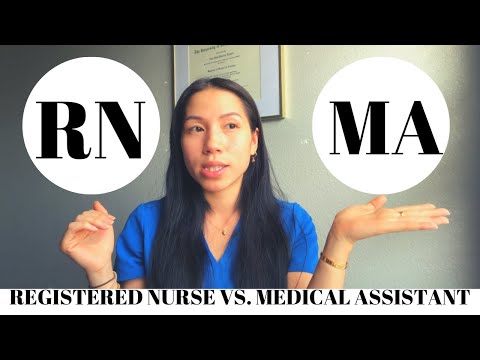The Bright Future of Medical Assistants
Contents
- Job Outlook for Medical Assistants
- The Duties of a Medical Assistant
- The Education and Training of a Medical Assistant
- The Skillset of a Medical Assistant
- The Personality of a Medical Assistant
- The Work Schedule of a Medical Assistant
- The Salary of a Medical Assistant
- The Benefits of Being a Medical Assistant
- The Career Progression of a Medical Assistant
- The Job Satisfaction of a Medical Assistant
Medical assistants are one of the fastest growing professions in the healthcare industry. With an aging population and the Affordable Care Act there is an increased demand for Medical assistants This demand is only expected to grow in the future.
Checkout this video:
Job Outlook for Medical Assistants
Medical assistants are in high demand and the job outlook for medical assistants is positive. The Bureau of Labor Statistics predicts that employment of medical assistants will grow by 29 percent from 2019 to 2029, much faster than the average for all occupations. This growth is due to the increasing number of aging baby boomers who will need medical care and the growing number of outpatient facilities, such as surgery centers and physician offices. As a result, there will be an increase in the number of medical procedures and tests that need to be performed outside of hospitals. Medical assistants will be needed to perform administrative and clinical tasks to support physicians in these settings.
The Duties of a Medical Assistant
Medical assistants are expected to handle both administrative duties and clinical responsibilities. Their daily tasks may vary depending on the needs of the medical facility where they work, but there are some standard duties that all medical assistants are typically responsible for.
Medical assistants typically greet patients as they come into the office and collect their personal information and medical history. They also take patients’ vitals, such as blood pressure and weight, and document this information in the patients’ files.
When patients meet with their doctor or another healthcare provider, medical assistants may be responsible for escorting them to exam rooms and taking notes on the visit. After the visit, medical assistants may give patients instructions on follow-up care or help schedule future appointments.
In addition to working directly with patients, medical assistants also play an important role in keeping healthcare facilities running smoothly. They may be responsible for handling insurance paperwork, scheduling appointments, answering phones, ordering supplies and maintaining patient records.
With the aging population in the United States and an increasing demand for healthcare services, the job outlook for medical assistants is very bright. According to the U.S. Bureau of Labor Statistics, employment of medical assistants is projected to grow 23 percent from 2016 to 2026—much faster than the average for all occupations.
The Education and Training of a Medical Assistant
Every profession has its own set of specific education and training requirements that must be met before an individual can practice in that field. The medical assistant profession is no different. A medical assistant is a multi-skilled health professional that supports the work of physicians and other health professionals, typically in an outpatient clinic setting.
While there are no formal education requirements to become a medical assistant, most employers prefer to hire candidates who have completed an accredited medical assisting program. These programs are typically offered at community colleges and technical schools and take between one and two years to complete.
During their training, medical assistants learn a wide range of skills, including how to take vital signs, administer injections, perform basic laboratory tests, schedule appointments, bill insurance companies, and more. Upon successfully completing a medical assisting program, students are often eligible to sit for nationally recognized certification exams.
While not required, many medical assistants choose to become certified in order to demonstrate their commitment to the profession and their competency in the skills necessary to perform their job duties. The two most popular certification exams for medical assistants are the Certified Medical Assistant (CMA) exam administered by the American Association of Medical Assistants (AAMA), and the Registered Medical Assistant (RMA) exam administered by the American Medical Technologists (AMT). Once certified, medical assistants must maintain their credential by earning continuing education credits on a regular basis.
The future looks bright for medical assistants! Employment of medical assistants is expected to grow much faster than average for all occupations between 2018 and 2028.* According to the U.S. Bureau of Labor Statistics (BLS), employment of medical assistants is projected to grow 29 percent during this time period – much faster than the average for all occupations (5 percent).** This growth is being driven by several factors, including an aging population (which requires more health care services), advances in medical technology (which requires more trained personnel to operate), and an overall increase in demand for health care services.
If you’re thinking about becoming amedical assistant, now is a great time to enter the profession!
The Skillset of a Medical Assistant
Medical assistants are a vital part of the healthcare team. They are responsible for providing patient care, administrative support, and clinical assistance to doctors and other medical professionals.
The skillset of a medical assistant is broad and varied. They must be able to juggle many tasks at once and be adaptable to the ever-changing needs of their patients. They must have excellent communication skills, both written and verbal, as well as exceptional organizational skills.
Medical assistants must be compassionate and caring, with a sincere desire to help others. They must be able to work well under pressure and maintain a positive attitude in the face of adversity.
The future of healthcare is bright, and medical assistants will play a vital role in making it happen. With their unique skillset and dedication to their patients, they will help make the world a healthier place for all.
The Personality of a Medical Assistant
Medical Assisting is a field with a long, established history of helping patients and doctors alike. This field has evolved over the years and the responsibilities of a medical assistant have changed as well. With the technological advances in medicine and an increased focus on customer service, the future of medical assistants looks bright.
Medical assistants are quick learners with excellent people skills. They enjoy working with others and helping people. They are able to maintain their composure in difficult situations and have a strong attention to detail. In addition, medical assistants must be able to handle confidential information with discretion.
The personality of a medical assistant is an important asset in this field. With the right personality, a medical assistant can thrive in this ever-changing field.
The Work Schedule of a Medical Assistant
Medical assistants often work full time in physicians’ offices. However, because some offices are open during evenings and weekends, medical assistants may work part time or rotating shifts. In large practices, medical assistants usually have more-defined roles, such as working in a laboratory, taking X rays, or handling billing and insurance matters. In small practices, medical assistants generally handle a variety of tasks, from patient care to clerical duties.
Most medical assistants work in outpatient care centers, hospitals, or offices of physicians. Some work in settings such as clinics that provide continuing care to patients with chronic illnesses; pharmaceutical companies; colleges and universities; or state and local health departments. A small number of medical assistants are self-employed.
The Salary of a Medical Assistant
Medical assistants are in high demand and the job market is expected to grow by 29% from 2019 to 2029, much faster than the average for all occupations.1 With such a bright future, it’s no wonder that many people are interested in becoming a medical assistant. But what does this career choice entail? In this article, we’ll explore the job duties of a medical assistant, the training and education required, and the median salary you can expect to earn.
Medical assistants are important members of the healthcare team. They perform many tasks to support doctors and other medical professionals, including taking medical histories, scheduling appointments, answering patient questions, checking vital signs, and assisting with minor office procedures.2 In some states, they may also be allowed to perform more advanced tasks such as administering injections or removing sutures.3
Most medical assistants have at least a high school diploma or equivalent, but many complete formal training programs offered by community colleges or technical schools.4 These programs usually last about a year and result in a certificate or diploma. Some medical assistants choose to further their education by completing an associate degree program, which typically takes two years to complete.5
The median salary for medical assistants was $34,800 in 2019.6 Earnings vary depending on experience, education level, geographic location, and type of employer.7 Medical assistants who have completed formal training programs generally earn more than those who have not.8
The Benefits of Being a Medical Assistant
Medical assistants are important members of the healthcare team. They are the link between the patient and the doctor. They perform a variety of tasks, such as taking medical histories, scheduling appointments, drawing blood, and giving injections.
There are many benefits to being a medical assistant. One benefit is that you can work in a variety of settings, such as hospitals, clinics, and doctor’s offices. Another benefit is that you can choose to work full-time or part-time. You also have the opportunity to specialize in a certain area of medicine, such as pediatrics or geriatrics.
One of the best things about being a medical assistant is that you can make a difference in the lives of others. You will be able to help patients receive the treatment they need and deserve. If you are looking for a career that is both challenging and rewarding, then consider becoming a medical assistant!
The Career Progression of a Medical Assistant
Medical assistants are in high demand and the field is expected to grow by 29% from 2016 to 2026, according to the Bureau of Labor Statistics. With such a large demand, many people are wondering what the career progression of a medical assistant looks like.
Most medical assistants start their careers working in doctor’s offices, clinics, or hospitals. They perform a variety of tasks, such as taking patient vital signs, scheduling appointments, and updating medical records With experience, medical assistants may be promoted to lead medical assistant positions or supervisors.
Some medical assistants choose to further their education by becoming certified registered medical assistants (RMA). To become an RMA, medical assistants must pass a nationally recognized exam and complete continuing education courses. RMAs often earn higher salaries than non-certified medical assistants.
Other medical assistants may choose to specialize in a particular area of medicine, such as optometry or podiatry. Specialized medical assistants often earn higher salaries than generalist medical assistants.
No matter what path they choose, medical assistants can rest assured that they will be in high demand in the years to come.
The Job Satisfaction of a Medical Assistant
The job satisfaction of a medical assistant is extremely important. Medical assistants are the backbone of any medical facility. They are responsible for handling patients, taking vital signs, and keeping the facility running smoothly. A satisfied medical assistant is a motivated medical assistant. A motivated medical assistant is an asset to any medical facility.
Medical assistants are in high demand and the job outlook for this career is very bright. The number of medical assistant positions is expected to grow by 29% from 2016 to 2026, much faster than the average for all occupations.1 This growth can be attributed to the aging baby-boomer population and their need for healthcare services. The Affordable Care Act has also increased the demand for healthcare services and, as a result, the need for medical assistants.
Medical assistants are typically very satisfied with their jobs. In fact, job satisfaction among medical assistants is higher than the national average.2 Medical assistants enjoy a variety of job responsibilities and have the opportunity to work closely with patients and other healthcare professionals. They typically work in well-lit and ventilated areas with little exposure to contagious diseases. In addition, most medical assistants work regular daytime hours with weekends and holidays off.
There are a number of factors that contribute to the high job satisfaction of medical assistants:
– The work is meaningful: Medical assistants help people every day by providing quality care and customer service. They make a difference in the lives of their patients and their families.
– The work is challenging: Medical assisting can be challenging at times, but this challenge is what makes the job interesting and rewarding. No two days are alike, which helps to keep things fresh and exciting.
– The work environment is positive: Most medical assistants work in clean, well-lit, and ventilated areas with little exposure to contagious diseases. In addition, they typically have regular daytime hours with weekends and holidays off.
– The pay is good: Medical assistants earn a median annual salary of $32,480 (or $15.60 per hour).3 Salaries vary depending on experience, geographic location, and type of employer







